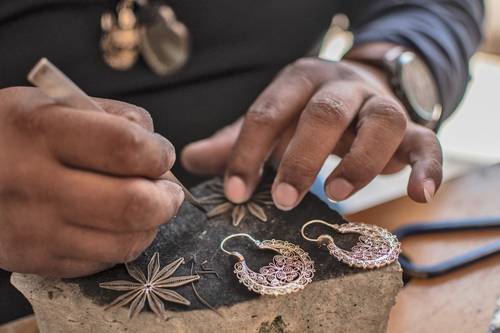Cándido Santiago’s large hands are transformed into a unique tool for making flower pendants, butterfly-shaped earrings, and shamrocks, among other traditional designs.Photo Diffusion of the Center for the Arts of San Agustín
With perfection and delicacy, Mexican artisans make filigree with techniques in danger of extinction
. As if they were in an operating room, they require concentration and dexterity to carry out an extremely complicated intervention, since a millimeter error could cause the agony of their work.
“They always ask me: ‘Why, if you have such big hands, do you manage to make such fine jewelry?’, says Cándido Santiago (Juchitán de Zaragoza, 1981) with a laugh, whose limbs are transformed into a unique tool to make flower pendants , earrings in the shape of butterflies and shamrocks, among other traditional designs.
Santiago is one of the 12 students who come from different entities and who participated in the quarterly filigree training program –a decorative technique that dates back to 2500 BC– offered by the San Agustín Center for the Arts (CASA), in Etla, Oaxaca. .
The filigree techniques that we studied focused on Oaxaca, Chiapas and Yucatán. One of the requirements was to have previous knowledge
explained the teacher of one of the educational modules in an interview with The Conference.
Although I only have a pair of rollers, jewelery pliers, filigree combs and a soldering bellows, the perfect combination is my rough hands and my thoughts. As soon as they propose me a model, my ingenuity manifests itself.
From the age of 9, Cándido Santiago learned filigree thanks to his uncle. The process hasn’t changed much. It is very laborious to work with thin wires and it is more complicated when working with gold, while it is a little easier to deal with silver, zinc and brass.
.
For Gabriela García Mariscal (Mexico City, 1986), her stay at the cultural center founded by the Oaxacan painter Francisco Toledo (1940-2019) represented an artistic adventure that changed her life.
It is important to disseminate the filigree technique because it embraces history, culture and tradition. Each region where this trade reappears is nourished by smiles, dreams and illusion. In addition, you learn a lot about social contexts through the diploma.
Gabriela was another selected from the more than 90 applicants who signed up for the CASA call. At 37 years old she developed a sixth sense to learn to hear the voice of silver and fire
. However, master classes from him would not be as pleasant. “Love, patience, commitment, dedication, discipline, practice and study are the essential attitudes and values to create filigree. (But) this goldsmith technique also confronts you with the biggest professional lesson: frustration.
When you learn a new technique, the learning curve is slow and you make a lot of mistakes along the way. So you have to work slowly, in daylight, take care of your posture, spin, anneal, comb and fill with millimeter care. With one more second of fire, the jewel will melt and you must start from scratch.
The tools used by García Mariscal are a laminator, a wire drawing die, a bellows torch, gasoline, files, round-nose pliers, cutters, fine-nose pliers, sandpaper, metal scissors, a filigree curling iron, and a ceramic or carbon partition. The supplement is an insatiable appetite for creating and materializing ideas
.
Wire frames filled with filigree, melipona bees (without stingers), rings, as well as amber, silver, golden obsidian and opal figures, designed with the Juchiteca technique by Cándido Santiago, are part of the new collection of the young artisan.
The graphic designer points out that “the main requirement to materialize a filigree jewel is to cultivate patience and determination. The process begins by casting the shot into a bar that is then thinned down the die, while three or four passes are made through the palace and the metal is annealed so that it does not break or splinter.
“The filigree is soldered with a fine powder that is obtained by filing the bar from the mixture of silver and brass, which melt at a lower temperature than silver 9.25 or 999 and with a mixture of mineral salts of boric acid, water and a bellows torch.
“In the diploma we learned to wind everything by hand, build tools, make frames, and generate volume in the filigree. There are pieces that are very traditional, they almost form part of the trousseau of a region; Craftsmen with new concerns abound, those who try to portray the present based on design and new techniques.
An essential part that we do not cover in the course is learning how to price a job. And it is that fellow artisans tend to make their products cheaper and even lose profits due to lack of professionalism in the financial field.
Another constant condition suffered by Mexican filigree artists is low back pain. García Mariscal clarifies that although it seems exaggerated, we jewelers live off our bodies
since the strenuous hours of work in the workshop do not favor their posture.
The filigree is not a simple technique, but it is very noble. In three months I was able to learn about other goldsmith styles that will allow me to evolve and differentiate myself in the market, as well as have my own aesthetic to better practice my trade. In the end, imagination is the limit
Gabriela concludes.
Daniel Brena, director of CASA, commented that one of the main ideas of the educational program was work with the best filigree artists that exist in Mexico
. Roberto Aguilar, one of the five teachers who taught the classes, recognized that the filigree is in danger of extinction
and, despite the fact that many interested parties come to his workshops with the idea of learning, few continue on that path
.
